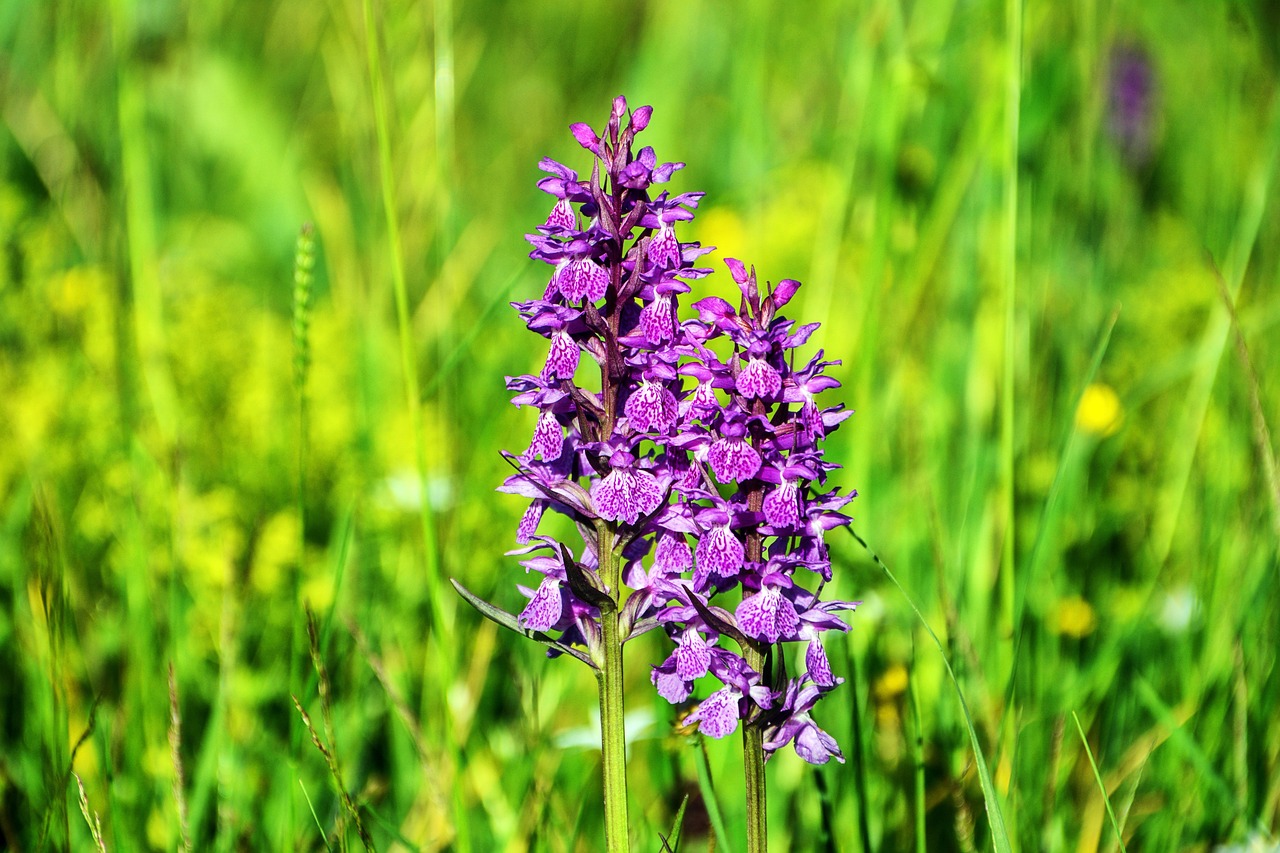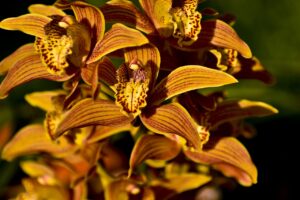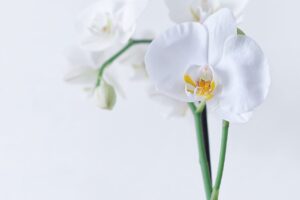Orchid
Overview
Orchids, belonging to the Orchidaceae family, are enchanting flowering plants notable for their vibrant and scented blossoms. As one of the most extensive plant families, they flourish in a variety of environments globally, except for the most frigid regions. Cherished for their beauty, orchids also hold various culinary and medicinal roles and are relatively manageable to grow at home with the proper care.

Characteristics
Known for their diverse species, vibrant flowers, and unique symmetry, as well as their ecological roles as pollinator attractors.
Region
Typically found in tropical regions of Asia, Central, and South America, but can grow in various climates worldwide, including North America.
Natural Habitat
Orchids are found in various habitats, including forests, grasslands, swamps, and even underground or on rocks.
Cultivation
Prefers indirect light, consistent moisture without waterlogging, and well-draining orchid-specific potting mix.
Uses and Benefits
Orchids offer a myriad of benefits that extend far beyond their captivating beauty. In the culinary realm, the vanilla orchid (Vanilla planifolia) reigns supreme, with its pods serving as the source of the beloved vanilla flavoring3. This versatile ingredient enhances countless desserts and beverages, adding a rich and aromatic dimension to culinary creations.
On the medicinal front, various cultures have long relied on orchids as a natural pharmacy. Different species are harnessed for their unique properties, offering potential remedies for a range of health concerns2. While more research is needed to fully understand their medicinal applications, the traditional wisdom surrounding orchids hints at their untapped potential.
Beyond their direct uses for humans, orchids play a vital role in maintaining the delicate balance of ecosystems. These fascinating plants form intricate relationships with specialized pollinators, such as orchid bees, which are essential for the survival of both the orchids and the bees2. This symbiotic relationship underscores the importance of orchids in sustaining biodiversity and the health of our planet.
In summary, orchids are far more than just a pretty face in the plant world. Their uses span from the culinary to the medicinal, while their ecological significance cannot be overstated. As we continue to explore the many benefits of orchids, we gain a deeper appreciation for these captivating plants and the multifaceted roles they play in our world.

Cultivation Tips
To cultivate orchids, embrace their love for a tropical vibe! Mimic their natural environment by providing plenty of humidity, dappled light, and well-draining growing mediums4. Unlike typical potted plants, orchids prefer to latch onto bark or float in the air with their roots free, just as they do in the wild5.
Water orchids with care, as their roots can’t stand to be soggy. When watering, do so thoroughly, allowing excess moisture to run away. Then, hold off until the growing medium dries out slightly5. Temperature is also key – most orchids appreciate a drop in night-time temperatures to trigger blooming5.
To ensure the health and beauty of your orchids, keep a watchful eye for these common issues:
- Pests: Regularly inspect your orchids for signs of pests such as aphids, mealybugs, and spider mites. If spotted, act quickly to prevent infestations from spreading.
- Diseases: Monitor your orchids for symptoms of fungal or bacterial diseases, such as leaf spots or root rot. Ensure proper air circulation and avoid overwatering to minimize the risk of disease.
With patience and attention, these alluring blooms can become a centerpiece in your home – a testament to the charm and diversity of the orchid family.
Seasonal Considerations
To cultivate orchids, embrace their love for a tropical vibe! Mimic their natural environment by providing plenty of humidity, dappled light, and well-draining growing mediums1. Orchids prefer to latch onto bark or float in the air with their roots free, just like they do in the wild.
Water orchids with care, as their roots can’t stand to be soggy. When you water, do it thoroughly, letting excess moisture run away, and then hold off until they dry out a bit. Temperature is also key – most orchids enjoy a drop in the night-time temps to trigger blooming.
Keep a keen eye out for these common seasonal considerations:
- Spring: As days lengthen and temperatures rise, increase watering frequency and begin fertilizing monthly to support new growth.
- Summer: Provide ample ventilation, shade from intense sunlight, and maintain high humidity. Water frequently, but allow the growing medium to dry slightly between waterings.
- Fall: Reduce watering and fertilizing as growth slows. Maintain cooler night temperatures to encourage flower spike development.
- Winter: Many orchids enter a dormant phase. Cut back on watering and fertilizing, but maintain humidity and protect from cold drafts. Provide bright, indirect light to support next season’s growth.
Watch for signs of pests and diseases throughout the year, as they can mar the beauty of these stunning plants. With patience and attention to their seasonal needs, orchids can become a charming centerpiece in your home, showcasing the diversity of this fascinating plant family.

Issues and Troubleshooting
Even the most resilient of orchids can sometimes face a few hiccups. If you notice your orchid’s leaves turning yellow, it could be a cry for less light or a plea for a watering schedule adjustment. Yellow leaves often signal that the plant is receiving too much light or that the watering frequency needs to be adjusted. Sometimes, drooping leaves might signal underwatering or a root system craving more air.
Ah, and beware of crown rot, a sneaky villain caused by water pooling in the plant’s crown. Always water at the base, never overhead, as your orchid will thank you for sparing its delicate heart. To prevent crown rot:
- Water your orchid at the base of the plant, avoiding the crown
- Ensure proper drainage to prevent water from accumulating
- Provide adequate air circulation around the plant
And when its blooms bid adieu, don’t despair. This could just be your plant’s way of saving energy for the next showstopping display. After blooming, your orchid may enter a resting phase, during which it will focus on growth and storing energy for the next flowering cycle.
Regular check-ins with your green friend will help you catch any mischief early, and with proper care guided by trusted resources1, you’ll enjoy the delicate beauty of orchids, hassle-free. Remember, patience and attention are the orchid’s best allies in your growing adventure.
History and Folklore
The enchanting orchids, with their magnificent and often fragrant flowers, hold a rich place in legend and lore. As one of the largest plant families, the Orchidaceae has captivated human imagination for centuries. These ethereal blooms are not mere decorations but are woven into the cultural tapestries of many societies.
In ancient Greece, orchids were associated with virility and fertility. It was believed that the tubers could determine the gender of unborn children1. The Greeks also linked orchids to male sexuality due to the resemblance of the plants’ paired underground tubers to testicles.
In Aztec culture, shamans consumed a potent elixir made from vanilla orchids and chocolate. This mixture was thought to bestow power and strength upon the drinker. Vanilla orchids were also cherished by the Aztecs for their fragrance and flavor, which they used to enhance beverages and dishes.
In Chinese culture, orchids are symbols of refinement, elegance, and beauty. They frequently appear in art and literature as representations of nobility, friendship, and scholarly pursuits. Confucius himself was said to have compared the virtuous person to an orchid, with its understated beauty and quiet integrity.
Beyond their cultural significance, orchids have also played a practical role in human history. The vanilla orchid, Vanilla planifolia, is the source of one of the world’s most beloved flavors and fragrances. Originally native to Mexico, vanilla orchids were first cultivated by the Totonac people and later spread globally through trade.
From ancient myths to modern cultivation, the history of orchids is as diverse and fascinating as the flowers themselves. These captivating plants continue to hold a special place in the hearts and minds of people around the world, weaving their way through our stories, traditions, and daily lives.
References
1. Orchid Care: How to Care for Orchids Indoors – The Old Farmer’s Almanac, https://www.almanac.com/plant/orchids
2. Exploring the orchid family tree | Kew, https://www.kew.org/read-and-watch/orchid-family-tree
3. Orchid – Wikipedia, https://en.wikipedia.org/wiki/Orchid
4. PDF Orchids: Culture – Missouri Botanical Garden, https://www.missouribotanicalgarden.org/Portals/0/Gardening/Gardening Help/Factsheets/Orchid Culture33.pdf
5. Orchid: Plant Care & Growing Guide – The Spruce, https://www.thespruce.com/basic-indoor-orchid-care-1902822
Image Credit: kareni
Image Credit: suresh_7076
Image Credit: jlxp
Nicolas Duval
Nicolas is a passionate advocate for nature and the art of wildcrafting. His dedication shines through in Wildcraftia, a website he meticulously crafted to serve as a haven for nature enthusiasts worldwide. Driven by a deep appreciation for nature’s connection to humanity, Nicolas embarked on his journey in 2011 with SmokableHerbs, a platform showcasing his love for nature’s bounty. Building upon this foundation, he established Smokably, a thriving online store offering premium herbs and blends to a global audience.
